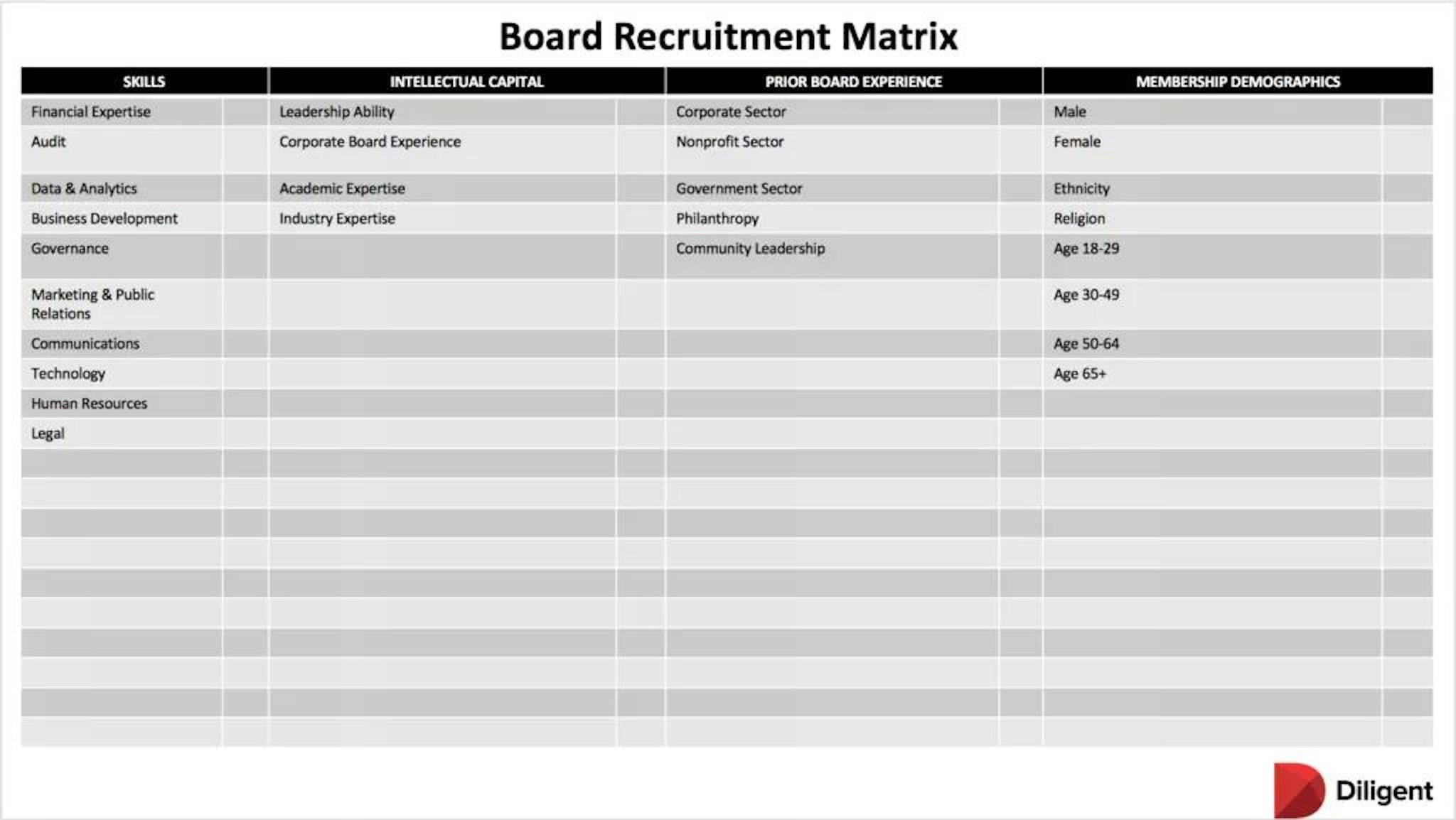Board recruitment matrix

Shareholders watch board directors all year long. They’re more likely to voice their concerns and opinions around proxy season. Shareholders are insistent that boards have independence, diversity and technology knowledge, and they want to see more women on boards.
Today’s nominating and governance committees have a tall order to fill when looking for board members to fill vacant board member seats. A continuous and thoughtful recruitment effort by the nominating committee will help to alleviate problems with shareholders at proxy time. Having the right qualifications and demographics often supersede board experience. In a perfect world, boards will have a stack of resumes to consider when board seats become available.
Taking Inventory of Current Board Skills
The New York Stock Exchange (NYSE) instituted a requirement for boards to conduct board self-evaluations beginning in 2009, which was a new concept for many boards at the time. The regulation started out as a check and balance on board composition and it’s gradually become accepted as a valuable tool for boards to evaluate their performance.
Board self-evaluations highlight board member strengths and weaknesses, which sets the stage for robust board discussions about any gaps and weaknesses on the collective board. When using board self-evaluations as a tool for evaluating the board’s needs, boards have several choices on how they go about approaching self-evaluations.
Boards can do evaluations on the whole board, individual board directors, or both. Regulators also require evaluations on the board’s major committees, which typically includes the audit, compensation and governance committees. Annual self-evaluations should make it evident if the contributions of board directors actually are what the board expected from them when the board initially recruited them. Evaluations should also set apart the workers from the slackers. NYSE Governance Services and RHR International published a survey about board self-evaluations in 2016 that revealed the most common board approaches to board self-assessment. The study showed that just over 80% of companies preferred peer evaluations or self-evaluations. A very small percentage of companies invited a third party to help facilitate the process. About 14% of companies invited outside counsel to assist in their self-evaluations and only about 11% of the companies requested a third-party professional to facilitate their evaluation process.
Board self-evaluations are far from a foolproof tool. There’s always the risk that some directors will fear speaking up. In addition, there’s the risk that some directors won’t be as candid or as truthful as they’d like to be out of fear that another board member may take well-intended criticism personally and create a negative impact of the board’s dynamics. In the worst-case scenarios, the results of board self-evaluations may inhibit communication between board directors and damage important board relationships. For board self-evaluations to be effective, all board directors need to go into the self-assessment process with the right attitude and an open mind. Transparency and engagement are important to the fidelity of the results.
While it’s important for boards to conduct annual self-evaluations, it’s also crucial that they have some sort of plan for the next steps to take once the results are in. The results may indicate that board directors should be informed about the results of their board performance. In cases where board directors are performing in a subpar way, boards should inform them that they’re performing below what the board expects and give them a chance to meet the company’s expectations.
At this point, boards should give them clear guidelines about what the board expects and make them aware that they’ll be monitored for a year. It helps to frame the conversation in a positive light, relating it to what the director can do better in the future, as opposed to focusing on their deficits.
Building Your Board Director Matrix
It’s easy enough to find a template for a board director matrix by doing a simple internet search. Alternatively, boards can just build one from a simple spreadsheet. Label the top with columns for the categories that you want to evaluate. Label additional columns with the names of current board directors.
Create rows across in which you can list the categories. That will form a grid where you can check which directors have strengths in the list of items in the category section. Boards can add whatever competencies and categories they wish. Here’s a list of common areas for evaluation: Skills
- Financial expertise
- Audit
- Data and analytics
- Business development
- Governance
- Marketing and public relations
- Communications
- Technology
- Human resources
- Legal
Intellectual Capital
- Leadership ability
- Corporate board experience
- Academic expertise
- Industry expertise
Prior Board Service
- Corporate sector
- Nonprofit sector
- Government sector
- Philanthropy
- Community leadership
Membership Demographics
- Male
- Female
- Ethnicity
- Religion
- Race
- Age 18–29
- Age 30–49
- Age 50–64
- Age 65+
Once the matrix is fully completed, the empty boxes will indicate gaps. These are the areas that the nominating and governance committee should focus on with their board director recruitment efforts.
Benefits of Board Management Software for Board Self-Evaluations
Diligent Corporation is an industry leader in board governance software. Diligent’s board self-assessment tool is just one of the many valuable tools that compose Governance Cloud — a fully integrated platform of software solutions for board directors. Diligent’s self-assessment tool ensures that boards are following best practices for governance while placing valuable data at the board’s fingertips.
Board of directors’ time is valuable. Off-the-shelf surveys and cumbersome spreadsheets are expensive and time-consuming. Annual self-evaluations don’t have to be that way. Diligent’s self-assessment tool streamlines the process for evaluations. Board directors can log in to the online platform and complete their assessments online at any time of day or night and from any location. Board directors also have the option of using a smartphone, electronic tablet or computer. The platform has a feature where administrators can insert a link that takes directors to helpful outside links for quick reference. If the process is easy enough for board directors, it’s even easier for board administrators. Admins can set up the evaluations using several formats for user-tested questions, informative glossaries and supplemental references. Admins can also view past evaluation results within seconds.
As submissions begin to come in, administrators can monitor the completion status, set open and close dates, and finalize questionnaires with a secure e-signature sign-off. The software calculates results along with visual graphics that boards can easily share electronically using an export wizard. Perhaps one of the best things about Diligent’s software is that it’s intuitive and easy to use. It’s the best way to ensure that board self-assessments are useful and meaningful.
Use this Board Recruitment Matrix to Better Guide Your Nom/Gov Committee
